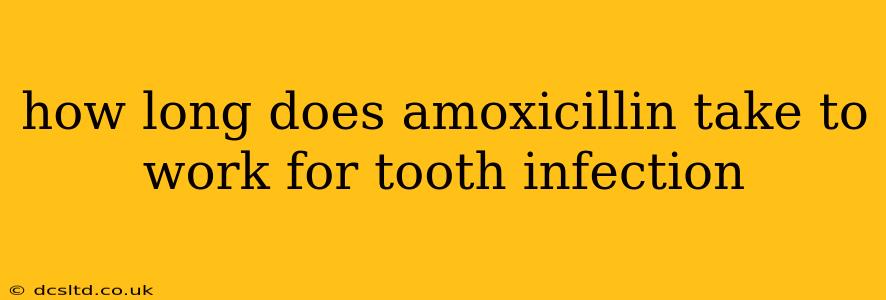How Long Does Amoxicillin Take to Work for a Tooth Infection?
A tooth infection, also known as a dental abscess, is a serious condition requiring prompt medical attention. Amoxicillin, a common antibiotic, is often prescribed to combat bacterial infections, including those affecting the teeth. But how long will it take to feel relief? The answer isn't a simple number of hours or days, as it depends on several factors.
This article will explore the timeframe for amoxicillin's effectiveness in treating tooth infections, address common questions, and highlight the importance of proper dental care.
What are the typical signs and symptoms of a tooth infection?
Before delving into treatment timelines, it's crucial to understand the indicators of a tooth infection. These can include:
- Severe toothache: A persistent, throbbing pain, often intensified by chewing or pressure.
- Swelling: Noticeable swelling in the gum tissue surrounding the affected tooth.
- Sensitivity to temperature: Extreme sensitivity to hot or cold foods and drinks.
- Pus: A yellowish-white discharge from the gum tissue.
- Fever: A high temperature, indicating the body's fight against infection.
- Bad breath: An unpleasant odor emanating from the mouth.
- Swollen lymph nodes: Swollen glands in the neck or jaw area.
If you experience these symptoms, seek immediate dental care. Do not attempt to self-diagnose or self-treat.
How long does it take for Amoxicillin to start working on a tooth infection?
You might start to feel some improvement within 24-48 hours of starting the Amoxicillin. However, this doesn't necessarily mean the infection is completely gone. The antibiotic needs time to effectively kill the bacteria causing the infection.
The noticeable reduction in pain and swelling usually indicates that the antibiotic is working. However, this is subjective and varies from person to person.
How long does the full course of Amoxicillin treatment typically last for a tooth infection?
A typical course of Amoxicillin for a dental infection lasts for 7-10 days. It's absolutely crucial to complete the entire course of antibiotics, even if you feel better before finishing. Stopping early can lead to the infection returning, potentially more resistant to the antibiotic.
What if my pain doesn't improve after starting Amoxicillin?
If your pain doesn't improve or worsens after a couple of days on Amoxicillin, contact your dentist or doctor immediately. There might be other underlying issues, or the infection might require a different approach. Delaying treatment can lead to serious complications.
Does Amoxicillin cure the underlying cause of the tooth infection?
Amoxicillin tackles the bacterial infection, but it doesn't address the root cause of the infection, which often involves a damaged or decayed tooth. Once the infection is under control, your dentist will likely need to perform further procedures, such as root canal treatment, extraction, or other restorative work, to permanently resolve the problem.
What are alternative antibiotics if Amoxicillin is ineffective?
If Amoxicillin isn't effective, your dentist may prescribe alternative antibiotics, such as clindamycin or metronidazole. The choice of antibiotic depends on the specific bacteria causing the infection and your medical history.
What other treatments might be necessary alongside Amoxicillin?
Besides antibiotics, your dentist may recommend other treatments, such as:
- Pain relievers: To manage the pain and discomfort.
- Drainage: In some cases, your dentist might need to drain the abscess to relieve pressure and promote healing.
Disclaimer: This information is for general knowledge and shouldn't be considered medical advice. Always consult with a qualified dental professional for diagnosis and treatment of a tooth infection. Self-treating can lead to serious complications. Seek professional dental care immediately if you suspect a tooth infection.
